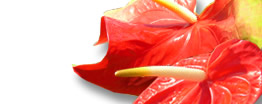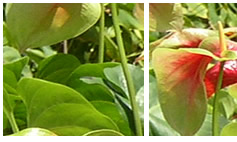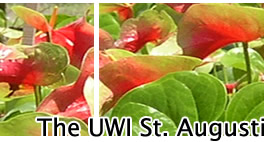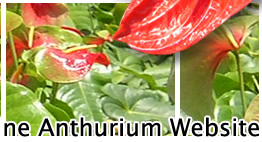 |
 |
||||
 |
 |
 |
|||
|
|
Horticultural Management Adaptation Anthurium is adapted to the humid tropics and will grow up to an elevation of 1500 m. The ideal conditions for growing and flowering anthurium depend on many factors of which potting medium; fertilizer and light levels may be considered the most important. The plants grow very well when, night temperature exceeds 15oC, maximum day temperature is about 35oC, and relative humidity is 70-80%, and 70-75% shade is provided. Shade may be provided by the use of shade saran. Caribbean farmers have showed that flower peduncles get longer and spathe size increases at lower light levels, but the number of flowers produced decreases. Land preparation and preparation of beds Anthurium is an epiphyte and hence requires special soil-free growing media, which are well aerated; but retains sufficient moisture and provides support to the plant. Raised- bed culture is recommended for commercial plantations rather than growing them in pots. Thus flat land is preferred for the construction of beds. However, if land is sloping, terracing would be recommended prior to preparing beds. A black or white plastic should be first placed on the ground before the beds are prepared in order to limit problems associated with soil borne pathogens. The beds should be about one foot tall and completely surrounded by chicken wire or other fencing material supported by sticks, concrete or metal rods. The beds are then filled with the growing media. Availability and cost are the main criteria that determine the choice of media used. Locally available raw material such as compost/leaf mould, coconut husk, sand, and coir dust may be used to prepare a suitable medium for plant cultivation. Coconut husk cut into 2.5 cm square pieces only may also be used as media. Every year this media should be topped up. Tree fern chips could also be used as a medium for anthurium culture. Planting density Plants can be spaced at 30 x 30 cm or 30 x 45 cm depending on the size that the plant will be when it reaches maturity. Triangular spacing would lead to an increase of 15% in plants in the same land area. Plants may be pruned down to four leaves per plant. Closer planting would require the continuous maintenance of 3 - 4 leaves per plant at all times. Weed control Weed control can only be achieved with constant manual weeding. Chemical control of weeds is not recommended, as many chemicals are phytotoxic to anthurium plants. Sometimes under too low light intensity, algae can grow on the leaf laminae and hamper plant photosynthesis. Increasing light intensity will cause the algae to die. Fertilization and pH maintenance For plants grown on media such as coconut husk, fertilisers having an N: P: K ratio of 20:20:20 may be sprayed as a foliar application. During flowering, ratios may be changed to 6:14:7 or 20:30:20. Fertilisers with the elements Ca, Mg and other microelements should also be added in liquid form. The pH of the media must be monitored and calcium carbonate should be added to maintain the pH at 5.5. Irrigation Anthurium plants need daily watering when rains are scarce. Hence, a perennial water system has to be available as a prerequisite to establishing a plantation. Water supplied to plants should be of good quality and be chlorine free. Overhead sprinkler systems are used in the Caribbean with great success. Fields are watered 3 times a day for 15 minute intervals in the dry season and as necessary in the wet season. Another method that can be exploited is drip irrigation. This method is initially more expensive but can later on reduce costs as it helps conserve water.
|
© 2004 - The University of The West Indies. All rights reserved. Disclaimer | Privacy Statement Telephone: (868) 662-2002 Fax: (868) 663-9684 |
|